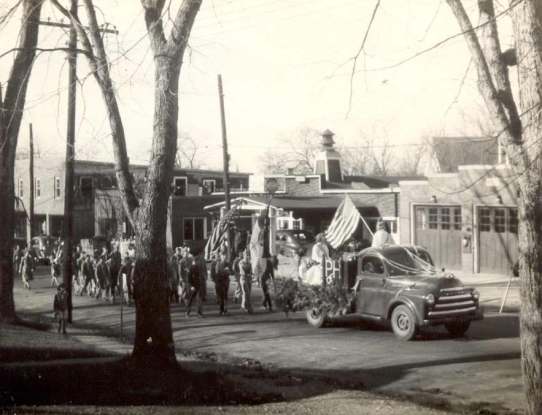Revisit Places to Eat in Hudson … Derby’s Dairy Bar C1950

Derby’s Dairy Bar on Ferry Street C1950
Derby’s was tucked away at the end of Ferry Street just before the bend in the road where Burnham Road begins. Probably remembered by just a handful of Hudson residents!!
George and Marion Derby opened their dairy bar at the end of Ferry Street in March 1950; advertising the best food cooked and served the way you like it!! A few years back I talked with my cousin Ray Parker about Derby’s. Ray and some of his high school friends had a small band. One day this group stopped into Derby’s, got talking, and as a result Mr. Derby offered them a place to practice. After all, it might help his business! For the next few months this group practiced and played at Derby’s. Ray found some old derby hats in his attic; thence their name became “The Derby Hatters”. This group contained 5 guys: Ray Parker on the drums, Dave Thompson at the piano, Wilford Boucher on the base fiddle, Lewis Carter with his sax, and a friend from Nashua on the trumpet. According to Ray, they did not play very long, nor did the dairy bar remain in business for long.
According to Manning’s Hudson Directory, Derby’s Dairy Bar and Trailer Court remained in business until 1954. That location became Moore’s Trailer Park and more recently Merrifield Park. It was located at the end of Ferry Street just before the name changes to Burnham Road. Photo courtesy of Gerry Winslow and now a part of the Historical Society Collection.
Further Destruction of Ferry Street

Memorial Day Parade at Hudson’s Business Center C 1945

Chicken ‘n’ Chips on Ferry Street C 1970
Places To Eat … The Meadows on Central Street

Places To Eat … The Meadows on Central Street
White Cross Store Complex

Roland’s White Cross Early
The plan to address the heavy traffic and congestion which had developed on the Taylor Falls Bridge between Hudson and Nashua by the early 1960’s was to have two bridges with one way traffic on each. A new bridge, The Veterans Memorial Bridge, north of the concrete Taylor Falls Bridge would handle west bound traffic from Hudson to Nashua. The existing concrete bridge would handle the east bound traffic from Nashua to Hudson. By July 1969 the bid process was completed and construction had began. The Veterans Memorial Bridge was dedicated and opened for traffic by September 1970.
During the five plus years before the opening of The Veterans Memorial Bridge, traffic increased further to the point that this became one of the busiest, if not the heaviest traveled bridge in the state. As early as March 1969 the search was on for funding to replace the ailing concrete bridge and in January 1970 the state announced it would be necessary to close the concrete bridge permanently once the new bridge was completed. The new bridge would be used for two-way traffic until plans were completed for a replacement to the Taylor Falls concrete bridge. There was competition for funding as plans were also being made to build the southern bridge connecting route 3A (Lowell Road) with route 3 in Nashua as part of the circumferential highway plans.
Even though the initial plan called for two bridges with one way traffic on each the design of the access roads were adaptable so that the new bridge could handle traffic in both directions should it become necessary; which it did! By March 1970 the state identified additional properties in both Hudson and the Nashua which were required for bridge access. On the Hudson side this included properties on Chase and Central Streets as well as on both sides of Ferry Street; including some frontage and the removal of trees on Library Park. The future of the old trolley stop was even in question!! The traffic pattern included the extension of Chase Street, which previously ended at School Street, through to Ferry Street. This week we will see the impact on the east side of Ferry Street and on the complex known as The White Cross Super Store.
We have two photos of the White Cross Store to share with you; one taken during the early years of the business and the second in 1968 during the last years of the business just prior to the state announcing that the building would be razed in order to accommodate access to and from the bridge(s).

White Cross Super Store as seen from Webster Street 1968